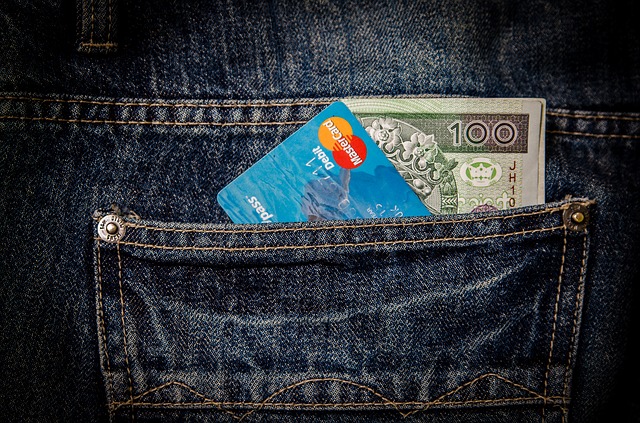Throughout May, Nathalie dives into money management for travelers in five parts. Which credit card is best? Can a regular ol’ traveler invest her money? Is it possible to earn and adventure at the same time? Nathalie has your most burning questions covered, so you can put those money worries aside and prioritize what truly makes you happy: travel.
Once you’ve figured out that travel is a priority for you and your budget, how do you manage your money on a day-to-day basis to make your travel dreams come true?
Start simple: A bank account
Are you mostly sticking to one place?
If you’re planning on staying primarily in one country, opening a bank account is really a non-issue, since you can choose any one of the multitudes that exist in that country.
There are some things you should always look out for, though:
- Any fees attached to your account
- Withdrawal and transaction limits
- Whether you need a minimum amount in your account at all times
- Whether there are enough ATMs to make accessing your money easy
Fast advice: I recommend never choosing a bank that charges you monthly fees. If you, like me, do use a bank account that charges monthly fees when you dip below a certain dollar amount in your account, check your balance on a regular basis, and always keep enough in there to stay above the limit. Why give your money to a bank when you could keep it for your travels?
Are you venturing out and about?
If you move around, the choice becomes more complicated than simply picking a bank that you like. It’s imperative to always have access to your money when you need it, no matter where you are on the planet.
I highly suggest going with a bank that’s in the Global ATM Network. That’s a network of international banks that permits no-fee ATM withdrawals as long as you use partner ATMs within their network. For example, if you have a Bank of America® ATM card, you can withdraw from a Deutsche Bank ATM in Germany without any fees!
The banks included in this network are:
- Bank of America
- Deutsche Bank
- BNP Paribas
- Barclays
- Scotiabank™
- Westpac
- China Construction Bank
- Several others
The network covers multiple dozens of countries. While there can be some fine print—China Construction Bank ATM fees are only waived for Bank of America cardholders—in general, the system is the best I’ve seen in terms of international availability for your money at no cost. I particularly like being with a bank within the network because I don’t like holding a lot of cash on me at one time. Knowing I won’t pay fees every time I want $20 US is helpful for this.

I also highly suggest having overdraft protection on your checking account. My account simply dips into my savings account if I go over my checking. This is helpful because many international ATMs won’t have access to your account information and so might not be able to show your balance. Being protected enough to be able to retrieve emergency money when needed helps my peace of mind.
Fast advice: Occasionally check your balance online to make sure you aren’t on overdraft for long periods of time!
Credit cards: Plastic to help you get…everywhere
Speaking of overdraft, checking accounts aren’t really the optimal way to manage money, especially when overseas: Credit cards are easier for buying items and making online purchases.
Fast advice (about debt): Under no circumstances is debt—credit card, line of credit, or loan—EVER necessary to travel. Debt begets debt, and it’s a slippery slope to go down. Using credit cards is meant to simplify the travel process, ensure the safety of your money, and maybe even take advantage of the cards’ rewards. Credit cards should never be used to travel with money that you don’t already have.
Think about this: If you keep a balance on your credit card for a trip today that you couldn’t pay for in full, the interest you are paying on that balance is effectively present-you robbing yourself of an even bigger trip that future-you could have taken!

That being said, when properly used, credit cards can be great for short- or long-term travel.
Here’s what you need to consider when applying for a new credit card:
When shopping around and applying for credit cards, it is very important to be honest with yourself about your spending habits. For example, I once applied for a card with a $20 annual fee because I wanted the 3% cash back on my purchases. However, after 6 months I saw that I did most of my spending with another one of my cards, meaning that the yearly 3% cash back wasn’t enough to cover the $20 annual fee. I quickly switched to the no-fee card offered by the same bank, which only gave 1.5% cash back but didn’t cost me a cent.
1. Rewards options (Isn’t that why we’re here??)
The number of points you get per purchase, if there are black-out dates for traveling, how easy it is to transfer points, the airlines and hotels you can transfer them to, etc.
2. Usability
Visa and MasterCard are the most common names, but make sure that whatever card you choose is accepted everywhere you go.
3. Foreign transaction fees
Any travel card worth its salt shouldn’t charge you transaction fees when overseas. If it does, run far away.
4. Annual fee
If you will make up for the annual fee (with purchases you would have been making anyway), then go for it. If the annual fee is more than the rewards you’d get, or you are going to force yourself to purchase more than you otherwise would just to get rewards, don’t bother; settle for fewer rewards without the added cost.
5. Interest rates
Honestly, I don’t remember the last time I looked at my cards’ interest rates. You shouldn’t be carrying a balance on any of your travel cards anyway, right? If you are, get a card with a low interest rate, and knock that balance out before your next trip.
6. Security, reliability, insurance
Credit cards are safer than debit and ATM cards if they’re stolen. With most cards, you might be responsible for the first $50, but if you call your bank as soon as you realize your card has been stolen, you’ll be reimbursed for any purchases that weren’t made by you. Most travel cards also have a fair amount of insurance included — trip cancellation insurance, rental car insurance, lost baggage insurance, etc. Be sure to check the policies, and don’t hesitate to call the provider if you aren’t sure of the details. They aren’t always written in the clearest and most concise manner!
Contrary to popular belief, you don’t have to get a credit card through the same bank as your checking account, so shop around everywhere; the bank with the best checking account for you might not have the best credit card for you.

For U.S. citizens, the following two cards seem to stand above the rest.
The first for its amazing rewards and the second for its versatility and lack of annual fee.
1. Chase Sapphire Preferred®
This card has been the gold standard for travellers for years. The biggest reason? It has a one-to-one transfer policy, meaning that one Chase point equals one point through any one of Chase’s travel partners. Almost every other card I’ve ever seen takes a certain cut in the transfer process, meaning 1,000 points could equal 875 partner points!
You also have the option of booking travel directly through Chase’s website and enjoying 20% off your travels. While each dollar spent equals one point (which is already pretty good), you get double the points for any and all of your traveling and eating spending.
Obviously, as a travel card, there are no foreign transactions fees (super important!). There is an annual fee of $95. It’s waived the first year, but it means that you have to be honest about your spending. If you use this card for most, if not all, of your daily spending, you can get back several times your annual fee in rewards points.
Check out the great sign-up bonuses too! Think: over $600 in travel credit if you spend $4,000 in your first 3 months.
2. BankAmericard Travel Rewards®
I live in Canada (where credit cards with rewards are known to be rather disappointing), but I am still a U.S.-tax-paying citizen and hold a U.S. bank account and credit card, and this is my personal card of choice. It’s one of the few U.S. cards with a chip reader, which is great, considering a vast majority of the rest of the world now uses the more secure chip-pin code rather than a signature for credit card purchases.
While the rewards aren’t as exciting as the Chase card mentioned above, you still get 1.5 points per $1 spent. This card works a little differently than many in that the points you rack up can be used to pay for travel purchases as they appear on your credit card statement: If you have $500 on your card this month, $300 of which was used for travel, you can use your points to pay for those $300 and your own money for the other $200.
I chose this card because, along with no foreign transaction fees, there is also no annual fee, and the sign up bonus was pretty nice as well: $200 worth of credit after spending $1,000 during my first 3 months.
For those of you not in the U.S., check out these websites to find the best card for you:
- Canadians, look at rewardscanada.ca — Fellow Canadians, watch out for AIR MILES® expiration dates. They’re an unfortunate change in policy meaning that rewards will now expire after five years. There goes the around-the-world ticket I was going to buy in 20 years!
- UK citizens, go to uk.creditcards.com.
- Australians, a great site for you is finder.com.au.
For any Wanderful women in other countries, I suggest searching “best credit cards travel rewards” online!
Now that you know where to responsibly keep your money for a traveling future, how are you going to make that money and protect it well enough to travel for the rest of your life? Check out the next post in this series, going live next week!
Did you miss Part 1? Read it here!
 Nathalie was raised by two immigrant scientists who taught her, from a young age, the value of a dollar and, most importantly, how to align her spending with her values above all else. She has always been fascinated by personal finance, and her deep love of the outdoors and simple living has led her to be a naturally frugal adult. Her parents taught her both the beauty of compounding interest and the importance of living below her means. As such, she is her own financial advisor, re-balancing her portfolio every quarter and investing in real estate in her home city — all on her modest budget.
Nathalie was raised by two immigrant scientists who taught her, from a young age, the value of a dollar and, most importantly, how to align her spending with her values above all else. She has always been fascinated by personal finance, and her deep love of the outdoors and simple living has led her to be a naturally frugal adult. Her parents taught her both the beauty of compounding interest and the importance of living below her means. As such, she is her own financial advisor, re-balancing her portfolio every quarter and investing in real estate in her home city — all on her modest budget.
Featured image by Pixabay user jarmoluk.
